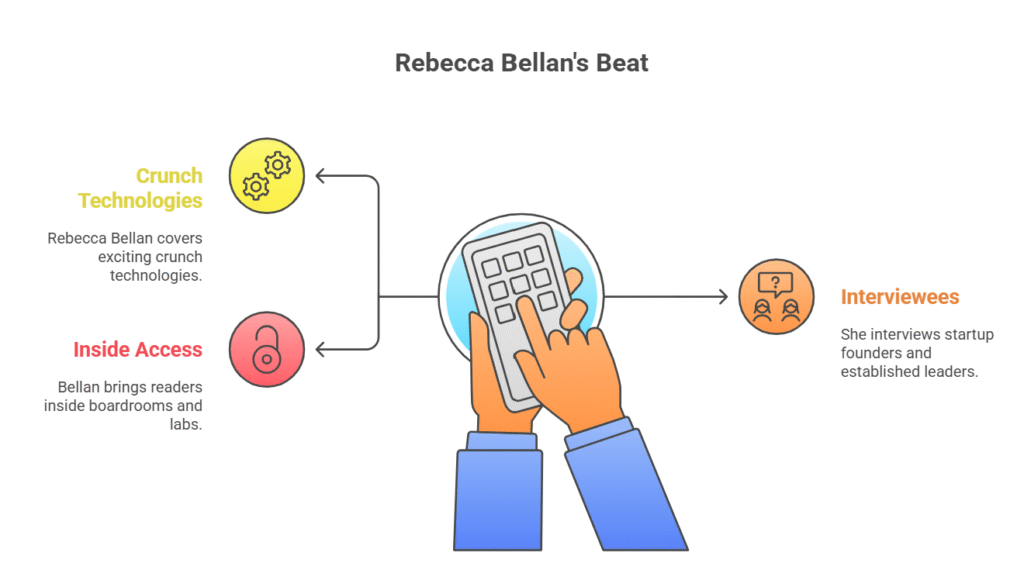BLOG
Rebecca Bellan TechCrunch: Powerful Insights – 5

Rebecca Bellan TechCrunch: Powerful Insights – 5 is more than just a name on a screen—she’s become a trusted authority in the world of tech reporting, especially when it comes to mobility, transportation, and the future of urban life. With a background in investigative journalism and a knack for breaking down complex topics, Rebecca has carved out a unique space at TechCrunch.
Her articles don’t just report the news; they analyze trends, ask tough questions, and often spark conversations across the industry. Whether she’s covering the latest EV startup, dissecting a new policy, or interviewing leaders like Jean Silva Tesla LinkedIn fame, Rebecca brings clarity and depth to every story.
“Rebecca Bellan’s coverage always gets to the heart of what matters. She doesn’t just crunch it—she explains why it matters for the rest of us.”
Why Rebecca Bellan TechCrunch Is a Must-Read for Industry Insiders
The Best in Tech Reporting
In a world where tech news can feel overwhelming, Rebecca’s work stands out for its accuracy, insight, and accessibility. She’s not afraid to challenge the status quo or highlight the risks and rewards of emerging crunch technologies.
Her reporting is often cited by other journalists, analysts, and even policymakers. If you want to understand where the industry is headed, following Rebecca Bellan TechCrunch is a smart move.
Crunch It: Breaking Down the Complex
One of Rebecca’s strengths is her ability to “crunch it”—to take complicated subjects and make them understandable for everyone. Whether she’s explaining the latest battery breakthrough or the implications of a new self-driving regulation, her writing is clear, concise, and engaging.
The TechCrunch Logo: A Symbol of Trust
When you see the TechCrunch logo at the top of an article, you know you’re getting news that’s been vetted, fact-checked, and written by experts. Rebecca Bellan’s byline under that logo is a further guarantee of quality.
TechCrunch has built its reputation on breaking big stories and providing in-depth analysis. Rebecca’s work continues that tradition, making her a key part of the publication’s ongoing success.
Crunch Technologies: The Future of Mobility and Urban Innovation
Covering the Next Wave
Rebecca Bellan’s beat often includes the most exciting crunch technologies—from electric vehicles and micromobility to smart cities and AI-driven transit. She’s interviewed everyone from startup founders to established leaders like Jean Silva Tesla LinkedIn profile, bringing readers inside the boardrooms and labs where the future is being built.

Real-World Impact
Her stories don’t just stay online. They influence investors, inspire entrepreneurs, and sometimes even shape public policy. When Rebecca covers a new technology, people pay attention.
Jean Silva Tesla LinkedIn: Industry Leaders in the Spotlight
Rebecca’s interviews with industry leaders are a highlight of her work. Take Jean Silva Tesla LinkedIn—a rising star in the EV world. Rebecca’s deep-dive interviews go beyond the press release, asking the questions that matter to both insiders and everyday readers.
Her ability to connect with sources and get them to open up is part of what makes her reporting so valuable. It’s not just about the news; it’s about understanding the people and ideas driving change.
The Human Side of Tech: Why Rebecca Bellan’s Reporting Resonates
Storytelling That Connects
Rebecca doesn’t just report on technology—she tells the stories of the people behind it. Whether it’s a founder’s struggle, a city’s transformation, or a community’s reaction to new mobility options, her articles bring a human touch to the world of crunch technologies.
A Real-Life Example
“I first read Rebecca’s piece on urban e-bikes and it changed how I thought about commuting. She made the tech feel accessible, not intimidating.”
The Risks and Rewards: Honest Reporting in 2025
Explaining the Pros and Cons
In 2025, the tech world is moving faster than ever. Rebecca Bellan’s reporting doesn’t shy away from the risks—whether it’s data privacy, regulatory hurdles, or the environmental impact of new tech. She lays out the pros and cons, helping readers make informed decisions.
Usability and Accessibility
Rebecca also focuses on usability—how new technologies actually work in the real world. Are they accessible? Affordable? Scalable? Her articles answer these questions, making her a go-to source for both industry insiders and curious consumers.
Crunch It: How Rebecca Bellan Makes Tech News Engaging
Short, Punchy Paragraphs
Rebecca’s writing style is easy to read, with short paragraphs and a conversational tone. She knows her audience is busy, so she gets to the point—without sacrificing depth.
Varied Tone for Every Reader
Some articles are friendly and approachable, others are more analytical or persuasive. Rebecca adapts her tone to the topic, making her work appealing to a wide range of readers.
The TechCrunch Community: Why Readers Keep Coming Back
Building Trust
The TechCrunch logo is more than just branding—it’s a promise of quality. Rebecca Bellan’s consistent, high-quality reporting helps build trust with readers, who know they can rely on her for the latest and most accurate information.
Engaging with Readers
Rebecca often engages with readers on social media, answering questions and sharing insights. This two-way conversation makes her reporting even more valuable.
FAQs
1. Who is Rebecca Bellan at TechCrunch?
Rebecca Bellan is a senior reporter at TechCrunch, specializing in mobility, transportation, and urban innovation. Her work is widely regarded as some of the best in tech journalism.
2. What topics does Rebecca Bellan cover?
Rebecca covers a range of topics, including electric vehicles, micromobility, smart cities, and interviews with industry leaders like Jean Silva Tesla LinkedIn. She’s known for her deep analysis of crunch technologies.
3. Why is the TechCrunch logo important?
The TechCrunch logo represents trusted, high-quality tech journalism. Articles under this logo, especially those by Rebecca Bellan, are known for their accuracy and insight.
4. How does Rebecca Bellan make complex tech news easy to understand?
Rebecca is known for her ability to “crunch it”—breaking down complex topics into clear, engaging stories that anyone can understand.
The Bottom Line
In a world where tech news is everywhere, Rebecca Bellan TechCrunch stands out for its clarity, depth, and human touch. Whether you’re an industry insider, a startup founder, or just curious about the future, her reporting is a must-read.
BLOG
Besos Meaning: A Journey into the Heart of Latin American Culture

Besos is derived from the Spanish language, where it translates to “kisses.” However, the meaning of besos goes beyond a simple translation. It’s a term that encompasses a range of emotions, from affection and love to passion and intimacy.
The Cultural Significance of Besos
In many Latin American cultures, besos are an integral part of daily life. They’re a way to show affection, greet one another, and express love. The cultural significance of besos is deeply rooted in the values of warmth, hospitality, and closeness.

The Different Types of Besos
While the term “besos” is often associated with romantic love, it’s not the only context in which it’s used. Besos can be exchanged between family members, friends, and even as a greeting or farewell.
- A beso on the cheek is a common greeting in many Latin American countries.
- A beso on the lips is often reserved for romantic partners or loved ones.
- A beso on the forehead or hand can be a sign of respect, affection, or blessing.
“I remember my abuela giving me besos on the forehead every night before bed. It was a special moment that made me feel loved and safe.”
The Emotional Significance of Besos
Besos are more than just a physical gesture; they’re a way to convey emotions and connect with others. The act of giving or receiving a beso can evoke feelings of comfort, security, and love.
FAQs
Q: What is the meaning of besos in Spanish?
A: Besos is the Spanish word for “kisses.” It’s a term used to describe a range of affectionate gestures, from romantic kisses to friendly pecks on the cheek.
Q: How do you use besos in a sentence?
A: You can use besos in a sentence to express affection or love, such as “Dale besos a tu familia de mi parte” (Give your family a kiss from me).
Q: What is the cultural significance of besos in Latin America?
A: Besos play a significant role in Latin American culture, where they’re used to show affection, greet one another, and express love.
Q: Can besos be used in non-romantic contexts?
A: Yes, besos can be used in non-romantic contexts, such as between family members or friends. It’s a way to show affection and closeness.
Conclusion
Besos, we discover that it’s more than just a word – it’s a way to connect with others and express our emotions. Whether you’re looking to deepen your understanding of Latin American culture or simply want to show affection to those around you, besos is a term that’s worth exploring further.
BLOG
Luxury Cruise Passengers: Staying Safe on the High Seas

Luxury cruises often traverse through exotic waters, some of which are notorious for piracy. The Gulf of Aden, the Indian Ocean, and parts of Southeast Asia are known hotspots where pirates have been active. These areas are often near popular cruise routes, putting luxury cruise passengers at risk.
Piracy Tactics: How Pirates Target Luxury Cruises
Pirates have become increasingly sophisticated, using tactics like GPS spoofing and fake ship identities to target unsuspecting vessels. They often look for easy prey, such as slow-moving ships or those with lax security. Luxury cruises, with their high-value passengers and cargo, can be attractive targets.
The Human Impact: Stories from Luxury Cruise Passengers
“I was on a luxury cruise in the Gulf of Aden when we received a piracy warning. The crew immediately took action, increasing security measures and altering our course. It was a harrowing experience, but thanks to their quick response, we were safe.” The fear and uncertainty that come with a piracy warning can be unsettling, but being prepared and knowing what to expect can make all the difference.
Staying Safe: Precautions and Measures for Luxury Cruise Passengers
To minimize the risk of piracy, luxury cruise lines have implemented various security measures. These include:
- Traveling in convoys or with naval escorts
- Implementing advanced security systems, such as radar and surveillance cameras
- Conducting regular security drills and training for crew members
- Increasing security personnel on board

What Luxury Cruise Passengers Can Do
While cruise lines take necessary precautions, passengers can also play a role in staying safe. Being aware of the risks and taking simple precautions, such as staying informed about piracy hotspots and following crew instructions, can help minimize the risk of piracy.
Piracy Warning Systems: How Luxury Cruises Stay Ahead
Luxury cruise lines use advanced piracy warning systems to stay informed about potential threats. These systems provide real-time updates on piracy hotspots and suspicious activity, enabling crews to take proactive measures to avoid danger.
The Role of Technology in Piracy Prevention
Technology plays a vital role in preventing piracy. Advanced systems, such as satellite tracking and AI-powered surveillance, help cruise lines stay one step ahead of pirates. These technologies enable crews to respond quickly and effectively in the event of a piracy warning.
FAQs
Q: What should I do if I receive a piracy warning on my luxury cruise?
A: If you receive a piracy warning, follow the instructions of your crew immediately. They are trained to handle such situations and will take necessary precautions to ensure your safety.
Q: Are luxury cruises more vulnerable to piracy than other types of cruises?
A: Luxury cruises can be attractive targets for pirates due to their high-value passengers and cargo. However, luxury cruise lines often have advanced security measures in place to minimize the risk.
Q: How can I stay informed about piracy hotspots and safety measures on my luxury cruise?
A: Your cruise line will provide you with information about piracy hotspots and safety measures in place. You can also stay informed through government travel advisories and industry reports.
Q: Can I travel safely on a luxury cruise despite the risk of piracy?
A: Yes, with the right precautions and awareness, you can travel safely on a luxury cruise. Cruise lines take piracy seriously and have measures in place to protect passengers.
Conclusion
Luxury cruise, staying informed about piracy risks and taking necessary precautions can help ensure a safe and enjoyable journey. By understanding the risks and being aware of the measures in place to prevent piracy, you can relax and enjoy your time on board.
BLOG
Mandarin for Mandarin: Tips and Tricks for Language Learners

Mandarin can be a rewarding and enriching experience, especially when you focus on learning Mandarin for Mandarin. By doing so, you can:
- Improve your pronunciation and intonation
- Develop a deeper understanding of Chinese culture and history
- Enhance your career opportunities in China or with Chinese companies
Immersing Yourself in the Language
One of the most effective ways to learn Mandarin for Mandarin is to immerse yourself in the language. This can be done by:
- Watching Chinese movies and TV shows
- Listening to Chinese music and podcasts
- Speaking with native Mandarin speakers
For example, “I started watching Chinese dramas with English subtitles and it really helped me improve my listening skills and get used to the natural flow of the language.”

Tips for Learning Mandarin for Mandarin
When it comes to learning Mandarin for Mandarin, there are several tips to keep in mind:
- Focus on tones and pronunciation
- Practice speaking and listening regularly
- Use language learning apps and resources
Using Language Learning Apps
There are many language learning apps available that can help you learn Mandarin for Mandarin. Some popular options include:
- Duolingo
- HelloTalk
- Pleco
FAQs
Q: What is the best way to learn Mandarin for Mandarin?
A: The best way to learn Mandarin for Mandarin is to immerse yourself in the language by watching Chinese media, speaking with native speakers, and practicing regularly.
Q: How can I improve my Mandarin pronunciation?
A: You can improve your Mandarin pronunciation by listening to native speakers, practicing speaking regularly, and using language learning apps that focus on pronunciation.
Q: What are some common challenges when learning Mandarin for Mandarin?
A: Some common challenges include mastering tones, understanding grammar and syntax, and finding opportunities to practice speaking and listening.
Q: Can I learn Mandarin for Mandarin on my own?
A: Yes, you can learn Mandarin for Mandarin on your own with the right resources and motivation. However, it’s also helpful to work with a language exchange partner or tutor to get feedback and support.
Conclusion
Mandarin for Mandarin requires dedication, persistence, and the right resources. By immersing yourself in the language, practicing regularly, and using the right language learning tools, you can achieve fluency and unlock new opportunities. Whether you’re a beginner or advanced learner, there’s always room to improve and refine your Mandarin skills.
-

 TECH6 months ago
TECH6 months agoApple iPhone 17: Official 2025 Release Date Revealed
-

 BLOG6 months ago
BLOG6 months agoUnderstanding the ∴ Symbol in Math
-

 EDUCATION6 months ago
EDUCATION6 months agoHorizontal Translation: How to Shift Graphs
-

 EDUCATION6 months ago
EDUCATION6 months agoUsing the Quadratic Formula
-

 EDUCATION6 months ago
EDUCATION6 months agoThe Meaning of an Open Circle in Math Explained
-

 HEALTH6 months ago
HEALTH6 months agoGoodNever: Wellness, Simplified
-

 EDUCATION6 months ago
EDUCATION6 months agoWhy Does m Represent Slope?
-

 EDUCATION6 months ago
EDUCATION6 months agoHow to Solve Quadratic Equations 2
